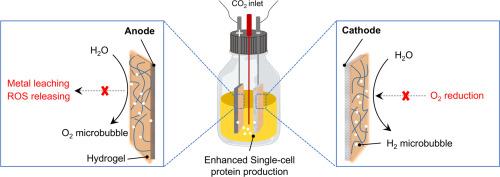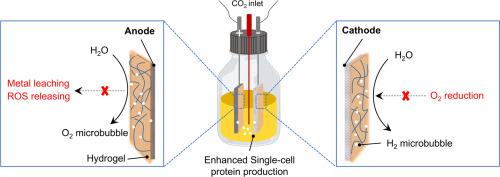增强蛋白质:水凝胶涂层电极如何增强生物杂交生产
IF 12.4
1区 环境科学与生态学
Q1 ENGINEERING, ENVIRONMENTAL
引用次数: 0
摘要
将水分解与固气微生物相结合,为利用可再生电力可持续生产化学品、燃料和食品提供了一条有前途的途径。然而,诸如气体利用率不足和不良副反应等挑战阻碍了这些系统的可扩展性。为了克服这些限制,我们提出并研究了一种通用的水凝胶包覆电极策略,以显着提高单细胞蛋白(SCP)从二氧化碳和电力的生产。水凝胶涂层促进了H2和O2的水凝胶剪切微泡的形成,同时增加了CO2,提高了Cupriavidus necator H16生长的气体利用率。此外,该策略显著降低了金属离子的释放(33.73%-89.32%),并限制了活性氧(ROS, 87.94%-100%)从电极上的扩散,这两者之前都抑制了细菌的生长和SCP的产量。这种双功能涂层在宽电压范围内增强了性能和保护,导致生物质产量增加20.56%,必需氨基酸含量增加55.96%-166.26%。在500 mL生物反应器中,生物质浓度为0.96 g/L,该方法具有很高的可扩展性和应用潜力,可用于各种生物混合电化学系统,实现高效生产增值产品。本文章由计算机程序翻译,如有差异,请以英文原文为准。


Powering up protein: How hydrogel-coated electrodes enhance biohybrid production
Integrating water splitting with gas-fixing microorganisms offers a promising route for the sustainable production of chemicals, fuels, and food using renewable electricity. However, challenges such as insufficient gas utilization and undesirable side reactions hinder the scalability of these systems. To overcome these limitations, we proposed and investigated a universal hydrogel-coated electrode strategy to significantly enhance single-cell protein (SCP) production from CO2 and electricity. The hydrogel coating facilitated the formation of hydrogel-sheared microbubbles of H2 and O2, alongside added CO2, improving gas availability for Cupriavidus necator H16 growth. Additionally, this strategy significantly reduced metal ion release (33.73%-89.32%) and restricted the diffusion of reactive oxygen species (ROS, 87.94%-100%) from the electrodes, both of which previously inhibited bacterial growth and SCP yield. This dual-function coating enhanced both performance and protection across a wide voltage range, leading to a 20.56% increase in biomass production and a 55.96%-166.26% increase in essential amino acid content. With a biomass concentration of 0.96 g/L in a 500 mL bioreactor, this approach demonstrates high scalability and potential for application in various biohybrid electrochemical systems, enabling efficient production of value-added products.
求助全文
通过发布文献求助,成功后即可免费获取论文全文。
去求助
来源期刊

Water Research
环境科学-工程:环境
CiteScore
20.80
自引率
9.40%
发文量
1307
审稿时长
38 days
期刊介绍:
Water Research, along with its open access companion journal Water Research X, serves as a platform for publishing original research papers covering various aspects of the science and technology related to the anthropogenic water cycle, water quality, and its management worldwide. The audience targeted by the journal comprises biologists, chemical engineers, chemists, civil engineers, environmental engineers, limnologists, and microbiologists. The scope of the journal include:
•Treatment processes for water and wastewaters (municipal, agricultural, industrial, and on-site treatment), including resource recovery and residuals management;
•Urban hydrology including sewer systems, stormwater management, and green infrastructure;
•Drinking water treatment and distribution;
•Potable and non-potable water reuse;
•Sanitation, public health, and risk assessment;
•Anaerobic digestion, solid and hazardous waste management, including source characterization and the effects and control of leachates and gaseous emissions;
•Contaminants (chemical, microbial, anthropogenic particles such as nanoparticles or microplastics) and related water quality sensing, monitoring, fate, and assessment;
•Anthropogenic impacts on inland, tidal, coastal and urban waters, focusing on surface and ground waters, and point and non-point sources of pollution;
•Environmental restoration, linked to surface water, groundwater and groundwater remediation;
•Analysis of the interfaces between sediments and water, and between water and atmosphere, focusing specifically on anthropogenic impacts;
•Mathematical modelling, systems analysis, machine learning, and beneficial use of big data related to the anthropogenic water cycle;
•Socio-economic, policy, and regulations studies.
 求助内容:
求助内容: 应助结果提醒方式:
应助结果提醒方式:


